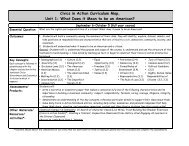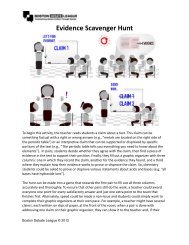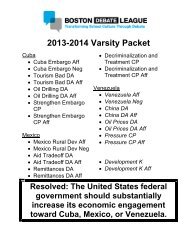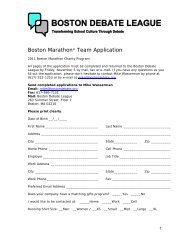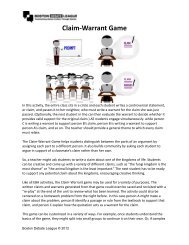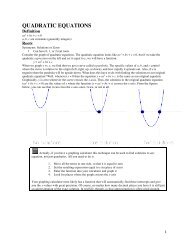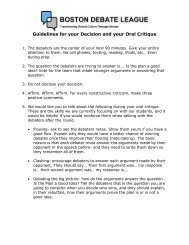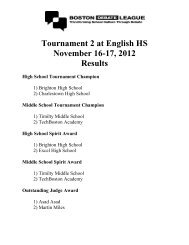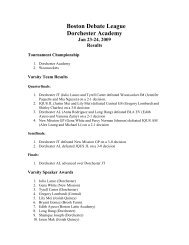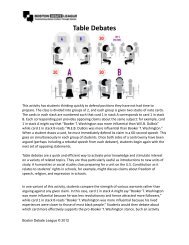10/29: Debate Center - JV and Varsity - Boston Debate League
10/29: Debate Center - JV and Varsity - Boston Debate League
10/29: Debate Center - JV and Varsity - Boston Debate League
Create successful ePaper yourself
Turn your PDF publications into a flip-book with our unique Google optimized e-Paper software.
Prior to the <strong>Debate</strong> <strong>Center</strong><br />
<strong>10</strong>/<strong>29</strong>: <strong>Debate</strong> <strong>Center</strong> - <strong>Varsity</strong><br />
This week, students wrote 1NC blocks that included analytic arguments <strong>and</strong> cards for both the Block<br />
Grants aff <strong>and</strong> Immigrant Health Care aff.<br />
Your Goals<br />
<br />
<br />
<br />
Students will underst<strong>and</strong> how to give a 1NC on case.<br />
Students will underst<strong>and</strong> how to debate line-by-line in the 2AC <strong>and</strong> Neg Block<br />
Students will further develop their flowing skills<br />
Materials Needed<br />
<br />
<br />
<br />
Affirmative <strong>and</strong> negative Immigrant Health Care files<br />
Immigrant health care 1AC pre-flows<br />
Flow pads or loose-leaf paper <strong>and</strong> pens<br />
The Lesson<br />
At debate center last week, <strong>and</strong> again in practice this week at school, students worked on 1NC blocks.<br />
So far, the focus has been on selecting two cards from their neg files <strong>and</strong> identifying two analytic<br />
arguments against each contention for a total of 16 arguments ((contention one, contention 2A,<br />
contention 2B, <strong>and</strong> solvency). Important: There is a mistake in the evidence packet- Contention<br />
Two A: is not labled. Page 5 of the 1AC should start with “Contention Two B: BioTerrorism”<br />
Based on feedback from last week’s debate center, this week students will continue to focus on case<br />
debate. Using the Immigrant Health Care aff, students will prepare (if they have not done so already)<br />
1NC case blocks, use the blocks in a mini debate, then respond to those blocks as the 2AC. Students will<br />
flow the 1NC <strong>and</strong> 2AC answers.<br />
Part One: Icebreaker<br />
1. Since some mentor groups have changed, introduce yourself to new students <strong>and</strong> ask all the<br />
students to introduce themselves to each other. Ask students to share something about<br />
themselves. Silly things work well: favorite childhood tv character, most despised food, biggest<br />
tantrum as a child, etc.<br />
2. Ask students what they did in class this week. (They should tell you they worked on preparing<br />
1NC blocks.) Ask them how far they got: which case, what contentions, etc.<br />
3. Explain to students that tonight, you are teach them how to debate against the immigrant health<br />
care aff, <strong>and</strong> how they can use their accordians to be better prepared during a debate.
Part Two: Mini Case <strong>Debate</strong>s<br />
1. Divide students into groups 4 groups. Assign each group one contention (split up the harms<br />
contentions). Have them write a summary for their contention, give them some time, then have<br />
them give it. Fill in anything that is missing/ ask other groups to repeat to make sure<br />
everyoneunderst<strong>and</strong>s.<br />
2. Keep the students in the same groups, but switch the assigned contentions. In their groups- have<br />
them come up with 2 evidenced answers <strong>and</strong> 2 analytical answers against their new contention<br />
(if they already have 1NC blocks- they will be more prepared).<br />
3. This would be a good time for a mentor to pre-flow the 1AC on the board. Leave enough space<br />
between each contention for speeches through the negative block.<br />
4. H<strong>and</strong> out copies of the Immigrant Health Care aff pre-flow.<br />
a. Ask students to pull out their copies of the 1AC <strong>and</strong> follow along as you discuss each<br />
page of the pre-flow.<br />
i. Explain the layout of the pre-flow: spaces between cards, separate sections for<br />
each speech, why the negative block only gets one column, etc.<br />
ii. Explain any confusing abbreviations or acronyms.<br />
iii. Point out that beneath the tag <strong>and</strong> source are key words that will help remind the<br />
debater of the content of the card when she or he gets ready for his or her speech.<br />
iv. Discuss numbering arguments.<br />
v. Finally, suggest to students that neat h<strong>and</strong>writing <strong>and</strong> underst<strong>and</strong>ing your<br />
partner’s shorth<strong>and</strong> is important, especially for the later speeches when your<br />
partner may need to rely on your flow her speech.<br />
5. Begin mini debates with the 1NC blocks.<br />
a. Ask the speaker selected for contention one to st<strong>and</strong> up <strong>and</strong> give her group’s response to<br />
contention one. Remind students to flow their responses <strong>and</strong> to number the arguments.<br />
Tell students that they will need an accurate flow of all the speeches for the next activity.<br />
b. After the speaker finishes the block, either give students time to compare flows within<br />
their smaller group or go through the flow together.<br />
c. Go over each argument as a team- ask the question…how does this argument prove the<br />
plan is a bad idea<br />
d. Repeat with the rest of the contentions.
6. 2AC answers.<br />
a. Now that students have given <strong>and</strong> flowed 1NC answer, explain that they not need to put<br />
on their affirmative thinking caps <strong>and</strong> answer these arguments as the 2AC.<br />
b. Shift the contention assignments to new groups. The contention 1 negative group<br />
becomes the contention 2 affirmative group, etc.<br />
c. Explain to students that they are now the affirmative <strong>and</strong> need to respond to the 1NC.<br />
Stress that they need to respond to all four arguments made by the 1NC.<br />
i. Explain that cards can be used to answer analytic arguments <strong>and</strong> vice versa.<br />
ii. Remind students that they can <strong>and</strong> should “pull” their original cards as long as<br />
they explain why those cards answer the 1NC’s argument.<br />
d. Each group will brainstorm answers <strong>and</strong> use their affirmative files to answer the 1NC<br />
arguments. When they are finished, ask each group to identify a new speaker, who will<br />
give the 2AC for the assigned contention.<br />
7. Writing 2AC blocks.<br />
i. Before each speaker, remind students to number their arguments <strong>and</strong> refer to the<br />
1NC arguments by number.<br />
ii. Prompt students during speeches if they are not referring to argumetns by number<br />
iii. After each speech, give the groups time to compare flows to ensure everyone has<br />
a good flow of the arguments. You could also review the flows together.<br />
a. This part of the lesson is a big deal. Our students don’t really do that much work at home<br />
because they do not know what work to do.<br />
b. Explain how they can now write 2AC blocks at home to all possible 1NC arguments.<br />
They can predict all of the evidenced arguments (they all have the same neg evidence),<br />
<strong>and</strong> they can predict some of the analytical ones (they should keep their flows from<br />
practices, debate centers, <strong>and</strong> tournmaments to remind themselves).<br />
c. Explain that a 2AC case block really shouldn’t be more than 3 arguments because they<br />
won’t have time to make more.<br />
d. Explain how they should file them in their accordian organized by contention so they can<br />
find them easier (pass out sample accordian h<strong>and</strong>out to illustrate).<br />
e. Stress the importance of writing these blocks/filing them in accordians/using the<br />
accordians during rounds.
8. The Negative Block (or skip to a quiz game)<br />
a. Ask students to lay their flows in front of them <strong>and</strong> try to think like the negative again.<br />
After the 2AC comes the negative block.<br />
b. Explain to students that because there are two negative speeches back-to-back, negative<br />
teams needs to divide the positions between them so that everything is answered, but<br />
nothing is answered twice.<br />
i. Point out that this is why there is only one column for the negative block, even<br />
though it is two separate speeches.<br />
c. Suggests students think strategically about the round when they divide the flow. The 1NR<br />
has a shorter speech, so he or she won’t be able to cover as much as the 2NR. But the<br />
1NR might have more time to prepare since the 2NC is followed by 3 minutes of CX.<br />
i. Remind varsity students that normally there would also be off case to cover, such<br />
as a DA.<br />
ii. Emphasize that students need to discuss <strong>and</strong> decide who is covering what. Don’t<br />
assume <strong>and</strong> don’t just wait until the 2NC speech to see what your partner has<br />
decided to cover.<br />
d. If time permits, shift groups again (i.e. the team that has already done problems 1 <strong>and</strong> 2<br />
now covers solvency) <strong>and</strong> repeat the same procedure for the negative block.<br />
9. Maybe end with some type of quiz game if you have time.



